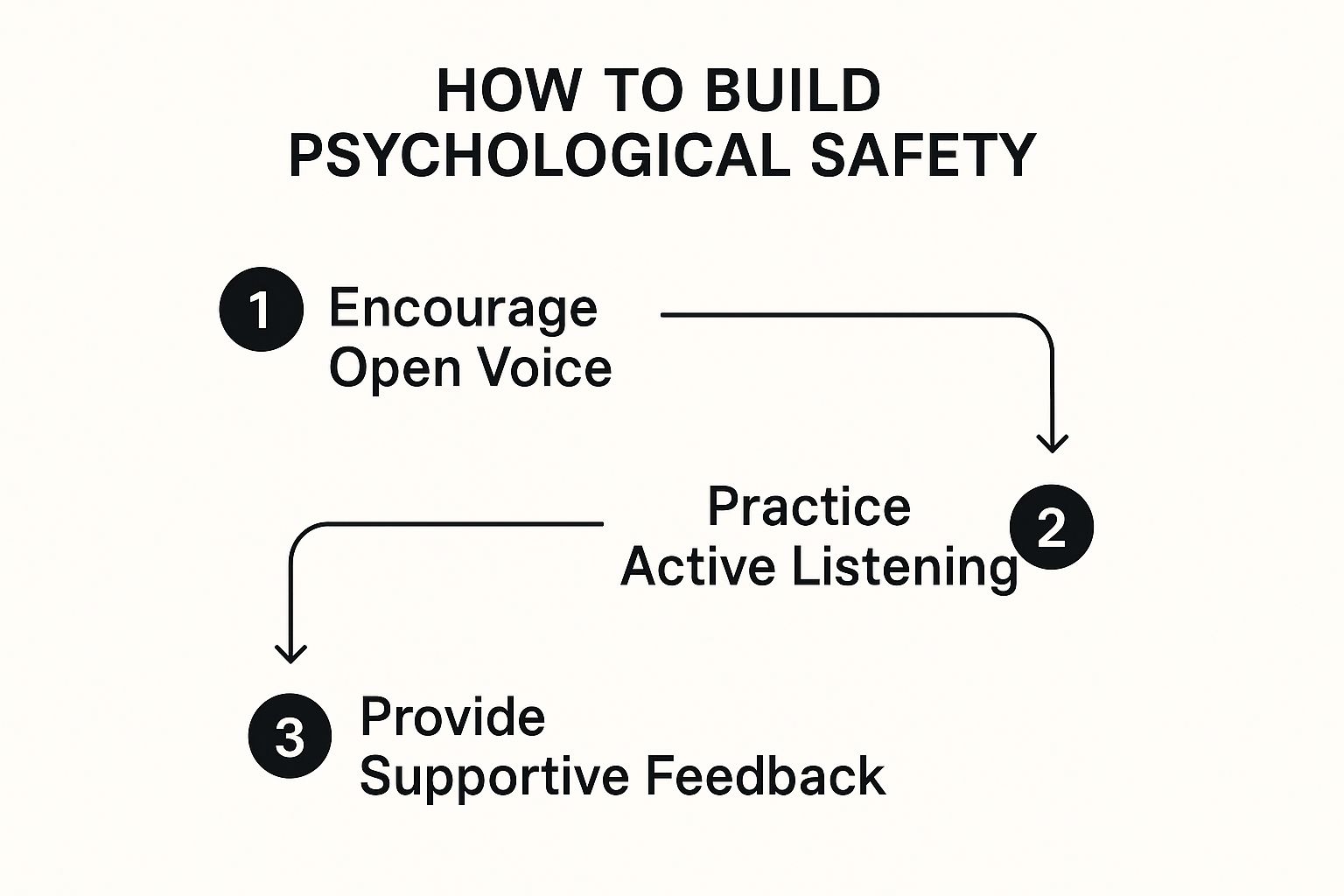How to Build Trust in Teams: Proven Strategies for Success
Building trust on a team doesn’t happen by accident. It’s not about grand, one-off gestures. Instead, it’s the quiet sum of countless small, consistent actions—in how we communicate, how reliable we are, and whether we create a space where people feel safe enough to be vulnerable.
These daily commitments are what truly transform a group of individuals into a tight-knit, high-performing team.
Why Trust Is Your Team's Greatest Asset
Let's get real for a moment. A team without trust isn't a team at all. It's just a collection of people working in the same general direction, usually bumping into each other along the way.
Picture a project where someone is falling behind, but they're too afraid to admit it. Instead of getting help and solving the problem early, you get a culture of blame, missed deadlines, and a thick cloud of anxiety. Innovation dies on the vine because nobody wants to stick their neck out for a bold idea that might not pan out. This is the expensive reality of a low-trust environment, and it’s a problem that can quietly sabotage an entire organization. You can dive deeper into what happens when you have widespread trust issues at work in our detailed guide.
On the flip side, high-trust environments are absolute game-changers. They create the psychological safety needed for people to give honest feedback, take creative risks, and collaborate with genuine enthusiasm. When people trust their colleagues and their leaders, they stop worrying about watching their backs and start focusing on doing incredible work.
The Tangible Benefits of a High-Trust Culture
Trust isn't some fluffy, "nice-to-have" concept. It's a hard asset that delivers very real, measurable results for your business. The data speaks for itself: when people feel trusted, they show up fully and bring their best efforts to the table.
What does that look like in practice?
- Better Well-being: Team members feel genuinely supported and psychologically safe, which has a huge positive impact on their mental health and overall job satisfaction.
- A Massive Productivity Boost: With less time wasted on navigating office politics or covering their tracks, people can channel all that energy into what actually matters—getting things done.
- Sky-High Engagement: Trust builds a powerful sense of connection to the team and its goals. People become personally invested in the collective success.
- Lower Burnout Rates: A supportive, trusting atmosphere is one of the best defenses against the chronic stress that leads to burnout.
The numbers are staggering. Research shows that employees in high-trust companies report 74% less stress, have 106% more energy at work, and are 50% more productive. These same teams also show 76% higher engagement and an incredible 40% less burnout. You can learn more about these powerful findings on 15five.com.
Before we dive into how to build this kind of environment, it helps to understand the core components that create a foundation of trust. I like to think of them as pillars holding everything up.
The Core Pillars of Team Trust
| Pillar | Description | Key Action |
|---|---|---|
| Reliability | Team members consistently follow through on their commitments. They do what they say they will do, when they say they will do it. | Model Consistency: Set clear expectations and always meet your own deadlines. |
| Honesty | People communicate openly and truthfully, even when the news is difficult. There's no hidden agenda or sugar-coating. | Embrace Candor: Encourage direct, respectful feedback and share information transparently. |
| Competence | Team members have the skills and knowledge to do their jobs well, and they trust in each other's abilities. | Showcase Skills: Give people opportunities to demonstrate their expertise and share knowledge. |
| Vulnerability | People feel safe enough to admit mistakes, ask for help, and be their authentic selves without fear of judgment. | Lead by Example: Be the first to admit you don't have all the answers or that you made an error. |
These four pillars don't stand on their own; they reinforce one another. When you have reliability and competence, it becomes easier to be honest. When you have honesty, it opens the door for true vulnerability. This is the bedrock you'll build your high-trust team on.
Foster a Culture of Open and Honest Communication

Here's a simple truth I've learned over the years: trust can't grow in silence. It absolutely thrives when communication is the lifeblood of the team, flowing openly and honestly between every single person.
This isn't about scheduling more meetings. It’s about creating an atmosphere where people feel genuinely safe to speak their minds, share the tough news, and offer real feedback without fearing a penalty. It’s a foundational step in building clear and transparent communications at work that make people feel seen and valued.
Ensure Every Voice Is Actually Heard
In almost every team, the loudest or most senior voices tend to dominate the conversation. If you want real trust, you have to intentionally carve out space for everyone else. It’s not just about being polite; it’s about tapping into the collective wisdom of your entire team.
Here are a few practical ways I’ve seen this work wonders:
- Go "around the horn." It's simple but effective. At the start or end of a meeting, go around the virtual room and ask each person for their take. It guarantees everyone gets a turn on the mic.
- Embrace asynchronous tools. Some of your best thinkers might not be your fastest talkers. Use tools like shared documents or Slack channels to collect thoughts before a big decision is made.
- Directly invite people in. Sometimes, all it takes is a simple, "Sarah, we haven't heard from you yet—what are your thoughts on this?" This can be a powerful and welcome invitation.
A project manager I once worked with turned a major project failure into one of our team's biggest trust-building moments. Instead of pointing fingers, she called a meeting and said, "Okay, this didn't work. I misjudged the timeline. What did we all learn?" By being transparent about her own role and focusing on shared learnings, she made it safe for everyone else to be honest.
Master the Art of Giving (and Receiving) Feedback
Feedback is essential for growth, but deliver it poorly, and you can shatter trust in an instant. The goal is to make feedback a tool for building people up, not for tearing them down. It's a subtle but crucial shift from criticism to constructive, supportive dialogue.
Try reframing your approach from blame to growth:
| Instead of This (Blame-Focused) | Try This (Growth-Focused) |
|---|---|
| "You were late with your report." | "I noticed the report was delayed. Is everything okay? How can I help you get back on track?" |
| "That's not a great idea." | "I appreciate you sharing that. Can you walk me through your thinking on how we’d handle the risks?" |
| "You need to be more organized." | "Let's brainstorm some strategies together for managing workload. What systems have worked for you in the past?" |
This approach does something incredibly important: it separates the person from the problem. It frames the entire conversation around collaboration and finding a solution together.
When your team members know feedback is coming from a place of genuine support, they're far more likely to listen and act on it. This creates a powerful cycle where honesty leads to improvement, which in turn builds deeper, more resilient trust across the entire team.
Build Trust Through Rock-Solid Reliability
If communication is the lifeblood of trust, then reliability is its backbone. It’s a pretty simple concept, really. People just need to know they can count on you—and each other—to actually do what you say you’re going to do. This is the stuff that turns a group of individuals into a real team.
This isn’t about micromanaging or tracking every last second of someone's day. Not at all. It's about fostering a culture where people hold themselves and each other accountable. When commitments are clear, out in the open, and consistently met, everything changes. That dependability lets people relax and focus on their own work, knowing their teammates have their backs. We dive deeper into what it means to be a person who is reliable and dependable in our companion article.
Make Commitments Clear and Visible
Vague expectations are where reliability goes to die. If no one’s quite sure what they’re supposed to do or by when, how can anyone possibly follow through? You have to start by setting crystal-clear expectations for every task and project, right from the get-go.
This is where shared tools come in handy. Think Asana, Trello, or even a well-organized shared spreadsheet. The point isn't to create a system for calling people out; it’s about creating shared clarity. When everyone on the team can see who owns what and when it’s due, accountability just becomes part of the natural rhythm of work.

The real takeaway here is that encouraging people to speak up is just the first domino. It’s what you do next—actively listening and responding with genuine support—that makes them feel safe enough to be truly reliable, even when things get tough.
Turn Proactive Communication into a Superpower
I’ve seen this exact scenario play out more times than I can count. A team member realizes they're about to miss a deadline. They can either go quiet and hope for a miracle, or they can speak up early.
I remember a junior developer on a huge project who realized he was stuck on a particularly nasty piece of code. It was two days before the deadline. Instead of trying to hide it, he went straight to his manager and said, "I've hit a wall and I'm worried I won't finish this on time. Here’s my idea for adjusting the timeline, and here's exactly where I need help."
That single act of proactive honesty did more to build trust than if he’d delivered on time without saying a word. Why? Because he gave the team the one thing they couldn't get back: time to adapt. He proved his commitment wasn't just to his task, but to the entire team's success.
And that’s the heart of it. Building trust through reliability isn’t about being perfect. It’s about being accountable and transparent, especially when things go sideways. When people know they can depend on your honesty just as much as your work, you’re building a foundation of trust that can withstand just about anything.
Foster Genuine Psychological Safety

This is where building trust gets really personal. If reliability is the practical, "get-it-done" side of trust, then psychological safety is its emotional heart. It’s that shared, unspoken belief that you won’t be punished or humiliated for speaking up with a new idea, asking a question, or—and this is a big one—admitting you made a mistake.
Let's clear up a common myth right away. This isn't about creating some conflict-free utopia where everyone is just overly “nice.” Not at all. Real psychological safety creates an environment tough enough to handle direct feedback, healthy debate, and even failure. Why? Because the underlying respect is rock solid. When your team feels safe, they stop performing and start contributing. This is absolutely vital for fostering employee engagement and value in a meaningful way.
The numbers don't lie. Recent research shows that a staggering 89% of employees believe psychological safety is crucial at work. This kind of emotional trust, built on the comfort of being open and vulnerable, is often a more accurate predictor of a team's success than just knowing someone will hit their deadlines. If you're curious, you can discover more insights about emotional trust at Gable.to.
Model Vulnerability from the Top
Psychological safety isn’t something that just pops up on its own; it has to be modeled, and that starts at the top. As a leader, you set the emotional temperature in the room. If you’re constantly projecting an image of perfection, your team will feel pressure to hide their own struggles.
The single most impactful thing you can do to build safety? Show your own vulnerability.
When you openly say, "You know what, I got that wrong," or "I actually don't have the answer to that," you’re giving your team permission to be human, too. This simple act can completely shift the team dynamic from one of judgment to one of shared learning.
- Share your learning moments: Talk about a time you messed up and what you learned from it.
- Actively ask for help: Say things like, "I could really use a different perspective on this. What am I missing?"
- Admit when you're uncertain: It’s powerful to say, "I'm not totally sure which way to go here, let's figure it out together."
React with Curiosity, Not Criticism
The moment someone brings you bad news or admits to a mistake is a moment of truth. If your knee-jerk reaction is to assign blame or show frustration, you’ve just taught everyone on your team to hide problems from you.
Instead, train yourself to react with curiosity. When a project goes off the rails, your first question should be, "Okay, what can we learn from this?" not "Whose fault is this?"
A fantastic example of this in practice is the 'blameless post-mortem.' When a system fails or a project doesn't hit the mark, many tech companies bring the team together not to point fingers, but to break down the process. The focus is 100% on finding weak spots in the system and making things better for next time.
This approach creates an incredible feedback loop. When people know that failure will be treated as a learning opportunity, they become much more willing to take smart risks. And those are the very risks that often lead to breakthroughs and true innovation. You’re sending a clear message: the team's growth is more important than any single mistake.
Close the Leader and Employee Trust Gap
One of the toughest hurdles in leadership is realizing you might not be as trusted as you think. It's a classic blind spot: leaders often feel they have a great rapport with their team, but the team's perspective can be worlds apart.
This isn't just a hunch; the data is pretty stark. One study found that while a whopping 86% of executives believe their employees trust them, only 60% of those employees actually agree. That’s a massive 26-point gap, and it's in that space where miscommunication, low morale, and stalled projects live. If you want to dig deeper, you can learn about the trust findings at Gable.to.
Closing this trust gap isn't about grand gestures. It's about earning it, day in and day out, through your actions. A job title doesn't automatically come with trust—your behavior is what builds it.
Conduct a Trust Audit
You can't fix what you can't see. Before you can build trust, you have to get an honest read on where you currently stand. This means creating safe, judgment-free ways for your team to give you the real story.
- Anonymous Surveys: Use a simple, confidential tool to ask pointed questions about trust, psychological safety, and communication. Keep it short and direct.
- One-on-One "Listening Tours": Set aside time with each person on your team. The agenda is simple: you listen. Ask open-ended questions about their experience and then just let them talk.
- Third-Party Facilitation: If you suspect deeper issues, bringing in a neutral facilitator can help create a space where people feel comfortable enough to be truly candid.
Remember, the point here isn't to defend yourself or find blame. It's to listen and learn. Just the act of asking for this feedback shows humility, which is a powerful first step in itself.
Your actions will always speak louder than your words. Trust is built in the small moments—how you respond to a mistake, whether you follow through on a promise, and if you listen more than you talk.
Align Your Words and Actions
Consistency is the bedrock of trust. When your team sees that what you say perfectly matches what you do, their confidence in you will soar. This isn't just about the big things; it's about being predictable and reliable in your everyday behavior.
Think about it: if you preach the importance of work-life balance but consistently send emails at 10 PM, your actions are screaming louder than your words. If you talk about transparency but then stay silent on key decisions, you’re creating doubt.
Every little inconsistency, no matter how minor it seems, chips away at the foundation you're trying to build. Building trust in teams means being the most dependable person in the room.
Use Team Activities to Strengthen Real Bonds

Let's be honest: nobody loves a forced trust fall or a cheesy icebreaker. Real team bonding isn't about manufacturing fun. It's about creating authentic, shared experiences that allow people to see each other as more than just a job title.
These moments, carved out from the daily grind of projects and deadlines, are where genuine connections happen. They're an investment in the human side of your team.
Well-chosen team activities can fast-track the trust-building process because they demand mutual support and creative problem-solving. This is a game-changer for team dynamics, and you can learn more about the benefits of forming relationships in the workplace in our other guide. When people have to rely on each other to solve a low-stakes, engaging challenge, they naturally build empathy and a deeper understanding of one another.
And this investment truly pays off. Organizations that make team building a priority often see a 25% jump in team performance and enjoy employee retention rates that are 36% higher. The data makes it clear: trust and a sense of belonging are directly linked to lower turnover, a point reinforced by these team-building statistics on TeamStage.
Choosing Activities That Actually Work
The secret is to pick activities that encourage genuine interaction, not just polite participation. Whether your team is fully remote, hybrid, or all in one place, the goal is the same: create a shared experience that requires real teamwork.
Here are a few budget-friendly ideas that get real results:
- Collaborative Problem-Solving: Try a virtual escape room or a mini "hackathon" to solve a fun, non-work-related puzzle. These activities are brilliant because they force everyone to communicate and think strategically together.
- Skill-Sharing Workshops: Invite team members to teach something they're passionate about. It could be anything from baking sourdough to coding a simple app or mastering a photography trick. This reveals hidden talents and builds a ton of mutual respect.
- Volunteer Days: There’s something powerful about working together for a good cause. It aligns the team around shared values and builds incredible camaraderie far away from the pressures of the office.
The most effective team-building isn't a one-off event—it’s a consistent part of your culture. It’s about regularly creating space for your team to connect on a human level, reinforcing that you’re all in this together.
Ultimately, think of these activities as strategic tools. They help break down professional barriers and build the personal rapport that makes collaboration feel effortless, communication more honest, and the entire workplace a more supportive place to be.
Your Top Questions About Building Team Trust, Answered
Let's face it, wrestling with team dynamics can be a real challenge. You're not alone. Here are some of the most common questions I hear from leaders trying to get this right.
How Do You Rebuild Trust Once It's Broken?
This is a tough one, but it's absolutely possible to come back from a breach of trust. The first step is always the hardest: own it. You have to acknowledge exactly what happened, head-on, with no excuses.
Take complete responsibility for your part, listen without getting defensive, and offer a genuine, heartfelt apology.
After that, words are cheap. It's all about consistent, trustworthy actions over time. Start by making small, manageable promises and then make sure you deliver on every single one. Think of it like making small deposits back into a trust account you've overdrawn. And throughout this entire process, transparent communication isn’t just nice to have—it's everything.
What Are the Telltale Signs of Low Trust on a Team?
It’s not always obvious, but there are definitely red flags. One of the biggest is a distinct lack of healthy debate. If your meetings are a sea of nodding heads, people are probably too scared to speak up and disagree. That's a huge problem.
Keep an eye out for these other warning signs:
- Constant gossip and back-channel conversations instead of open dialogue.
- A "blame game" culture where no one takes ownership when things go wrong.
- Leaders who micromanage every little detail instead of empowering their team.
- A noticeable hesitation from people to ask for help or share crucial information.
How Can You Build Trust on a Remote or Hybrid Team?
When you’re not sharing the same physical space, you have to be way more deliberate about building connections. Spontaneous chats don't just happen, so you have to create them.
Whenever possible, default to video calls for important discussions. Seeing someone's face and reading their body language makes a world of difference.
A simple but effective trick is to create dedicated "just for fun" channels in your team's communication tool, like Slack or Microsoft Teams. It’s the digital version of the water cooler, and it’s where real rapport is built. Also, make it a habit to over-communicate and regularly give public shout-outs for great work.
At JIMAC10, we're all about giving you the insights and tools you need to build a high-trust, high-performing team. Ready to create a more connected and productive work environment? Explore all of our resources at https://jimac10.tube.
Share this content:







































1 comment